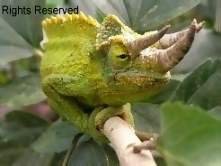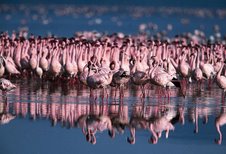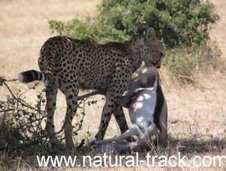Species
There are 6 species of flamingos in the world, At first glance, they may look similar to each other, but certain features such as size, leg colour or beak allow easy identification.
\Today, we will major on the lesser Flamingo as we explore their vast and diverse facts as follows;
Behavior;
Flamingos are itinerant species adapted to respond to changes in local environmental conditions, and thus depend on a network of suitable sites. They feed on species of microscopic cyanobacteria and benthic diatoms found only in alkaline lakes.
The characteristic feeding is primarily by swimming and filtering the algae and diatoms with a specialized bill that contains up to 10,000 microscopic lamellae. The Lesser Flamingos depend primarily on shallow saline/alkaline lakes, pans, wetlands and coastal areas within easy flying distance (i.e. 120-180 km) of a good feeding site for the parents.
They feed several hours each day when the surface of the water is sufficiently calm to enable them to feed. If the surface of the water is not calm, they are unable to feed and are confined to the limited areas of wet mud.
Species Classification
They are classified as “Near Threatened”, nearly qualifying as threatened under criteria A3c: (A population size reduction of 30%, projected or suspected to be met within the next 10 years or three generations, whichever is the longer -up to a maximum of 100 years), based on a decline in area of occupancy, extent of occurrence and/or quality of habitat.
It is also listed in Columns A and B of the Agreement on the Conservation of African-Eurasian Migratory Water birds (AEWA) Action Plan, Appendix II of the Bonn Convention (CMS) and Appendix II of the CITES convention.
Conservation
There are four separate populations recognized for conservation purposes;
1. The largest population, estimated to be 1.5 – 2.5 million individuals, occurs on the alkaline-saline lakes of the Great Rift Valley in East Africa.
Smaller populations occur in the
2. North-western India, estimated to be approximately 390,000 birds.
3. Southern Africa, estimated to be 55,000 – 65,000 birds.
4. West Africa, estimated to be 15,000 – 25,000 birds.
Maturity
They reach sexual maturity at 3-4 years of age and they breed following seasonal rains that provide the flooding necessary to isolate remote breeding sites from terrestrial predators and the soft muddy material for nest building. Nests are built from mud substrates where they lay eggs. The mean incubation is 28 days and Fledgling is approximately 70 days.
The selection of breeding site is chosen in regard to; Inaccessibility to terrestrial disturbance from humans or animal predators and subject to seasonal flooding that is sufficiently shallow (and calm) to enable the construction of the traditional conical mud nests without them being washed away, but sufficiently deep and long lasting to prohibit terrestrial predators from reaching the nesting colony.
Threats to flamingo conservation
Most critical threat to the survival of the Lesser Flamingo (a factor causing or likely to cause very rapid declines >30% over 10 years or three generations) is the degradation of its specialized breeding and feeding habitats through
1. Altered hydrology and water quality
2. Wetland pollution,
3. Extraction of salt and soda ash
4. Disruption of its few breeding colonies by human activities
There are also threats of High importance (factors causing or likely to cause rapid declines (20-30% over 10 years or three generations)
- Poisoning (heavy metals, pesticides & cyanobacteria toxins)
- Diseases – Avian flu, cholera, mycobacteriosis
- Disruption of its few breeding colonies by human activities (particularly from nearby settlements).
- Human disturbance of non-breeding sites
- Collision with man-made structures
- Predation
- Competition with other species for food and breeding sites
- Harvesting of eggs and live birds.
Enjoy your view of Flamingos!
PKP. safaris in kenya desk








